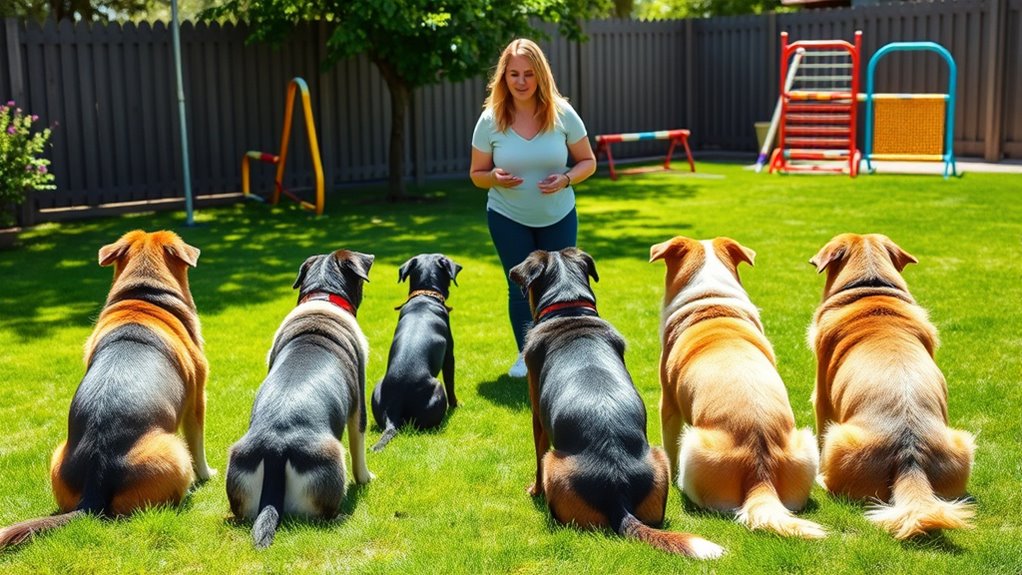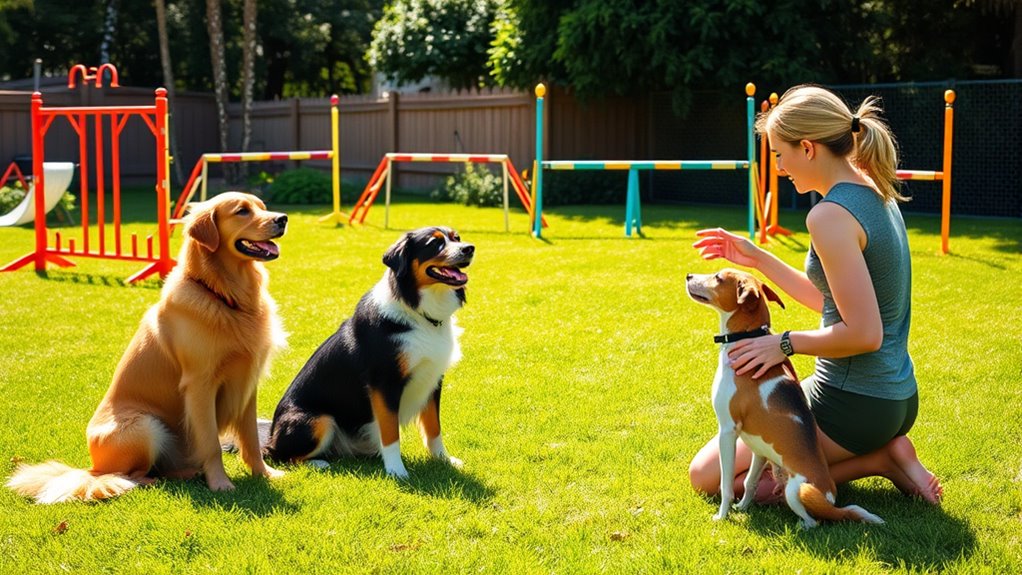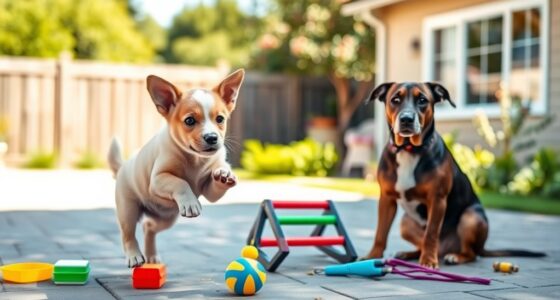To train multiple dogs at once, establish consistent routines and clear boundaries to prevent confusion. Use positive reinforcement to encourage good behavior and socialize each dog gradually, supervising interactions carefully. Incorporate crate training with separate crates for individual needs, and remain patient as they learn at different paces. Prioritize gentle, organized training sessions to foster harmony in your household. Keep these tips in mind, as you’ll discover more strategies to keep your dogs happy and well-behaved.
Key Takeaways
- Establish consistent routines to provide stability and clear expectations for all dogs.
- Use supervised, separate sessions for individual training to address specific behaviors effectively.
- Incorporate positive reinforcement to encourage calm, respectful interactions among multiple dogs.
- Use crates strategically to create safe spaces and prevent resource guarding or conflicts.
- Be patient and organized, gradually increasing independence while monitoring each dog’s social comfort.

Training multiple dogs at once can be challenging, but with the right approach, it’s entirely achievable. One of the most important aspects of managing a multi-dog household is ensuring each dog gets proper socialization. Dog socialization helps your pets learn how to interact calmly and respectfully with each other, reducing conflicts and building a peaceful environment. To promote effective socialization, set aside supervised playtimes where dogs can get comfortable around each other. Use positive reinforcement to encourage gentle behavior and calm interactions. Avoid harsh corrections, as they can create fear or resentment. Consistency is key—make socialization a regular part of your routine, and always monitor interactions until you’re confident they can handle more independence.
Another critical element is implementing effective crate training techniques. Crate training isn’t just about confinement; it’s about creating a safe space for each dog and establishing boundaries. When training multiple dogs, you need to be strategic about your crate setup. Use separate crates for each dog to prevent resource guarding and ensure they don’t feel intimidated or stressed. Start by introducing the crates gradually, making them inviting with treats, toys, and comfortable bedding. Use positive reinforcement every time a dog enters or relaxes in their crate to build positive associations. When you’re training multiple dogs, it’s helpful to establish a routine where each dog spends time in their crate, especially during periods when you need to focus on training or household tasks. This routine not only promotes independence but also minimizes chaos and competition.
Consistency is essential when working on crate training techniques with multiple dogs. Set clear rules—like no dogs in the crate during meal times unless specified—and stick to them. If one dog is more hesitant or takes longer to adjust, be patient and avoid rushing the process. Remember, each dog learns at its own pace, so tailor your approach accordingly. Use commands consistently, such as “crate” or “bed,” and reward compliance with treats and praise. This will help each dog understand what’s expected and build confidence in their space.
Balancing socialization and crate training with multiple dogs requires patience and organization. Keep routines predictable, and always supervise interactions until you’re confident they’re safe. Proper training techniques and a gentle, consistent approach will help your dogs develop good habits and a strong bond with you. By establishing solid socialization habits and employing effective crate training techniques, you set the foundation for a harmonious household where all your dogs can thrive together. It’s a lot of work, but with dedication, you’ll find that managing multiple dogs becomes a rewarding experience.
Frequently Asked Questions
How Do I Prevent My Dogs From Distracting Each Other During Training?
To prevent your dogs from distracting each other during training, keep training sessions short and focused. Use high-value treats and clear commands to maintain their training focus. Work with one dog at a time in a quiet, distraction-free area, and gradually reintroduce the other dogs once the desired behavior is achieved. Consistent routines and positive reinforcement help minimize dog distraction and guarantee each dog stays engaged during training.
What Are the Best Tools for Managing Multiple Dogs Simultaneously?
Managing multiple dogs is like herding cats, but the right tools make it easier. Use leash management to keep each dog focused and prevent chaos. Treat dispensers are also essential—they reward good behavior instantly and keep their attention on you. Combining these tools helps you maintain control, reinforce training, and makes managing multiple dogs more efficient and less stressful. With consistency, you’ll see better results and happier, well-behaved pups.
How Can I Ensure Individual Dogs Receive Sufficient Attention?
You can guarantee individual attention by dedicating focused time to each dog daily, engaging in personalized training sessions that cater to their unique needs and temperaments. Use separate commands and praise to reinforce their progress, and create one-on-one moments to build trust. This approach helps each dog feel valued, strengthens your bond, and ensures they receive the personalized training necessary for effective learning and behavior management in a multi-dog household.
What Are Signs My Dogs Are Stressed During Group Training?
You’ll notice your dogs’ stress signals like tucked tails, flattened ears, or avoiding eye contact—these are their dog body language telling you they’re overwhelmed. Yawning, lip licking, or excessive panting also hint at stress. When you see these signs, it’s like a storm brewing in their minds, so give them space and calm reassurance to help them feel safe again. Recognizing these cues keeps training positive and harmonious.
How Do I Handle Conflicting Behaviors Among Multiple Dogs?
When conflicting behaviors arise, you should focus on behavior modification and consistency training. Address each dog’s behavior individually, using positive reinforcement for desired actions and redirecting unwanted ones. Stay consistent with commands and routines to help them understand expectations. Avoid rewarding conflicting behaviors, and calmly correct or redirect them. This steady approach builds clear boundaries, reduces confusion, and encourages harmony among your dogs.
Conclusion
Training multiple dogs at once is like conducting a symphony—each dog plays a essential part, and harmony comes from patience and consistency. With clear commands and positive reinforcement, you’ll turn your lively pack into a well-oiled team. Remember, every moment is an opportunity to shape behavior and build bonds. Stay committed, stay calm, and watch as your dogs transform from chaos to camaraderie, creating a melody of obedience that’s music to your ears.










